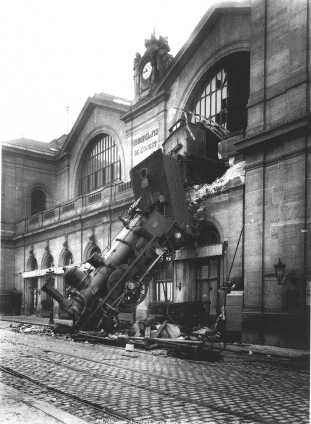The Intermittently Holy Church of Transport TycoonThe Story of the Gare Montparnesse Wreck |
October 23, 1895 - Gare Montparnesse, Paris, France The train left Granville at 0845 and was travelling a few minutes late as it approached Montparneasse at 1555. Pellerin was an experienced engineer of 19 years standing. Although he was understandably anxious to make up the lost time, he would have been well aware of the rule that forbade drivers to use the Westinghouse brake to bring trains to a halt at Gare Montparnasse. This was an economy measure to reduce the brake shoe wear. Engineers were expected to use the locomotive brake with the hand brakes on the brake cars. On this occasion however, he guided his train at speed into the station. He attempted to apply the Westinghouse brake, but it failed to operate. He was left with only the locomotives brakes to stop the train. But owing to the speed and the weight of the train, these were inadequate for the task. The two conductors on board realised that they were entering the station at a speed which was too high to stop safely. One of them at least, Albert Mariette was pre-occupied at this time. Although he should perhaps have been alert to the situation of the train, he was instead concentrating on completing his paperwork. It was at the last moment that he realised the train's plight and he attempted to apply the handbrake. He had barely begun to turn the handle when the locomotive ploughed through the buffer stop. The Granville to Paris express failed to stop at the dead ended Gare Montparnasse station in Paris, careered across 100ft of concourse and though the glass fronted end wall and into the street. Carrying 131 passengers in 12 cars, the train was in charge of a 2-4-0 class 120 #721 driven by Guillaume-Marie Pellerin. The train was made up of twelve vehicles. Two luggage vans and a postal van were coupled behind the locomotive. There followed eight passenger carriages and another luggage can coupled at the rear. He misjudged the speed and attempted to apply the air brake at the last minute but failed to stop. The engine careered across almost 100 feet of the station concourse, crashed through a two feet (0.6m) thick wall, across a terrace and sailed out of the station as it plummeted onto the street 30 feet (9m) below. This was the Place de Rennes which carried the tramway between the station and Place de l'Etoile. The falling locomotive just missed hitting one of the trams. Both engineer and fireman had bailed out before the engine hit the wall. The front three vehicles were extensively damaged, but all the passenger carriages remained on the track. There were only five serious injuries amongst those travelling on the train. There were two passengers, the fireman and the two conductors. However, beneath the window stood a woman Marie-Augustine Aguilard selling newspapers. She was standing in for her husband while he went to collect the evening papers. She was killed and another woman injured. The railway company paid for her funeral and a pension for her two children. Driver Pellerin and Conductor Mariette were both prosecuted. The driver was found guilty by virtue of having driven the train too fast. He was fined 50 francs and sentenced to two months imprisonment. He was not however required to serve the term of imprisonment. Mariette was also at fault for not having applied the Westinghouse brake himself. He was fined 25 francs. |
